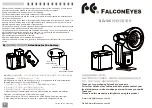
6
51
2x M4 4,0
17,8
17,8
M3 3,0
D
B
A
C
9,8
7
19
50
7,8
69,6
einschalten abgesichert wurde. Bei Zuwiderhandlung
besteht Verletzungsgefahr.
Bei Tätigkeiten im Arbeitsbereich der Werkzeugma-
schine besteht Verletzungsgefahr durch Kanten. Tragen
Sie geeignete Schutzausrüstung.
Stellen Sie vor Beginn der Arbeit sicher, dass
anzuschließende Druckluftkomponenten ausgeschaltet
sind und machen Sie das System drucklos. Bei
Zuwiderhandlung besteht Verletzungsgefahr.
Die Montage der Kamera kann auf unterschiedliche
Weise vorgenommen werden. Achten Sie darauf, dass Sie
die Kamera so einbauen, dass Wärme ausreichend abge-
führt werden kann. Eine Installation in eine Blechwand ist
hierfür ausreichend.
Die Gewinde sitzen in einer Linie mit den Sensorposi-
tionen. Für eine Ausgabe im Querformat müssen die
Schraubpositionen (C) auf einer Horizontalen liegen. Für
Hochformat entsprechend auf einer Vertikalen, siehe
Abbildung 3.
Befestigung des Kameramoduls
Neben dem optional erhältlichen Befestigungszubehör
kann die Kamera nach individuellen Wünschen befestigt
werden.
Um den Durchbruch in der Gehäusewand abzudichten
legen Sie den Dichtungsring in die dafür vorgesehene Nut
(D) ein (beiliegend).
Als Befestigungsschnittstelle befinden sich, wie oben
beschrieben, zwei M4-Gewinde (C) auf der Rückseite des
Gehäuses.
Zur Befestigung sind, wie in Abbildung 3 gezeigt, die zwei
auf der Rückseite im Abstand von 51mm befindlichen
M4-Gewinde (C) zu verwenden.
Die Einschraubtiefe darf max. 4mm betragen, das
Anzugsdrehmoment max. 1,5Nm.
Das an die Schnittstelle (A) angeschlossene Kabel sowie
der Druckluftanschluss (B) können offen im medienbe
-
aufschlagten Raum liegen, sofern sie durch Beschuss von
Spänen oder anderen scharfkantigen Teilen geschützt
sind.
Schließen Sie das Datenkabel mit dem angespritzten
Stecker an die entsprechende Schnittstelle (A) auf der
Rückseite an. Verbinden Sie den Steckanschluss mit Ihrer
Druckluftversorgung (B).
Abbildung 3
Figure 3
switched back on. Failure to observe this will result in a
risk of injury.
Tasks performed in the working area of the
machine tool entail the risk of injury due to sharp edges.
Wear suitable protective equipment.
Before beginning work, ensure that compressed air
components to be connected are switched off and ensure
that the system is completely depressurized. Failure to
observe this will result in a risk of injury.
The assembly of the camera can be performed in various
ways. Ensure that you install the camera such that heat
can be adequately dissipated. Installation in a sheet metal
panel is sufficient for this purpose.
The screw threads are located in a line with the sensor
positions. For output in landscape format, the screw
positions (C) must be located along a horizontal line. For
portrait format, they must be along a vertical line, see
Figure 3.
Mounting the camera module
In addition to the optionally available mounting
accessories, the camera can be mounted
according
to
individual
requirements.
To seal the opening in the housing wall, insert the
sealing ring into the groove (D) provided (enclosed).
As described above, two M4 threads (C) are provided
on the back of the housing as mounting interface.
For mounting, use the two M4 threads (C) on the
rear side at a distance of 51mm, as shown in Figure 3.
The screw-in depth may be max.
4mm,
the
tightening
torque
max.
1.5Nm.
The cable connected to the interface (A) as well as
the compressed air connection (B) can be left open
in the media-loaded space, provided that they are
protected by shavings or other sharp-edged parts.
Connect the data cable with the moulded plug to the
corresponding interface (A) on the rear. Connect the
plug connector to your compressed air supply (B).




































